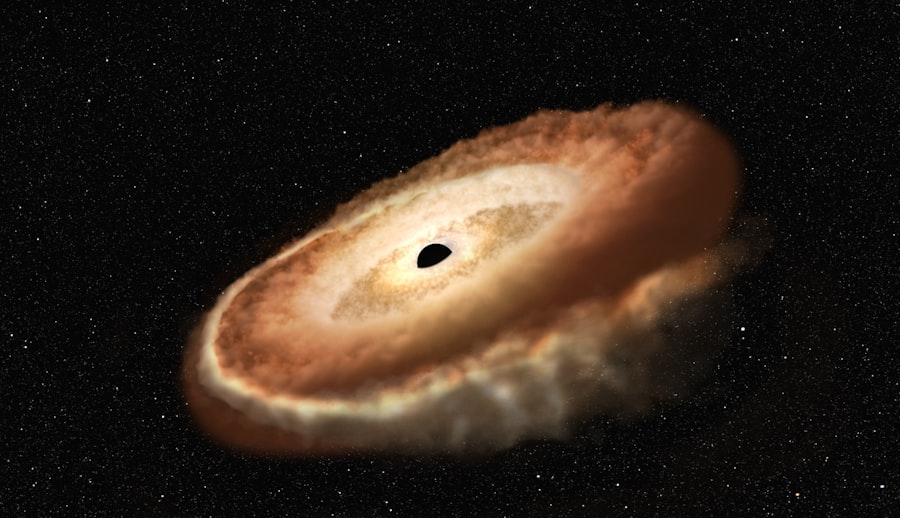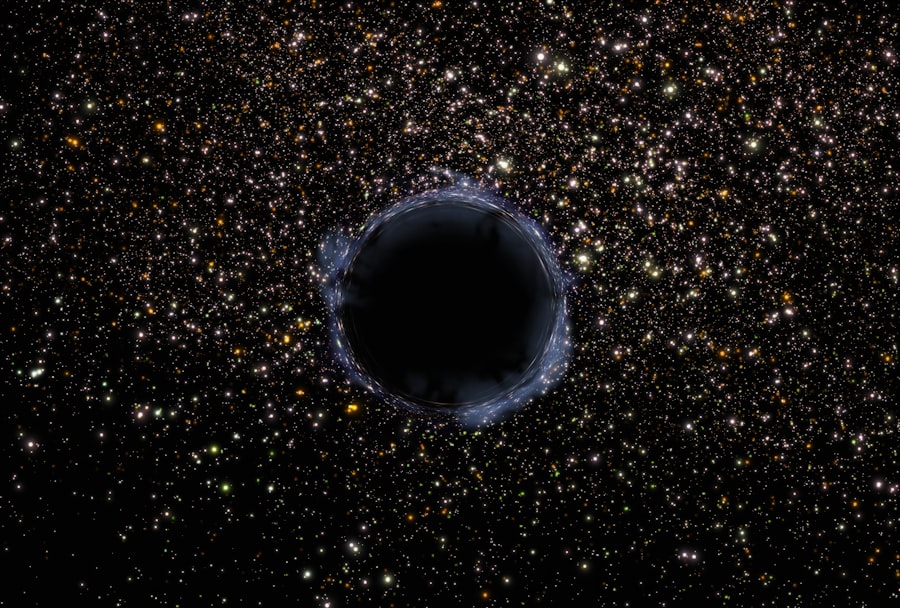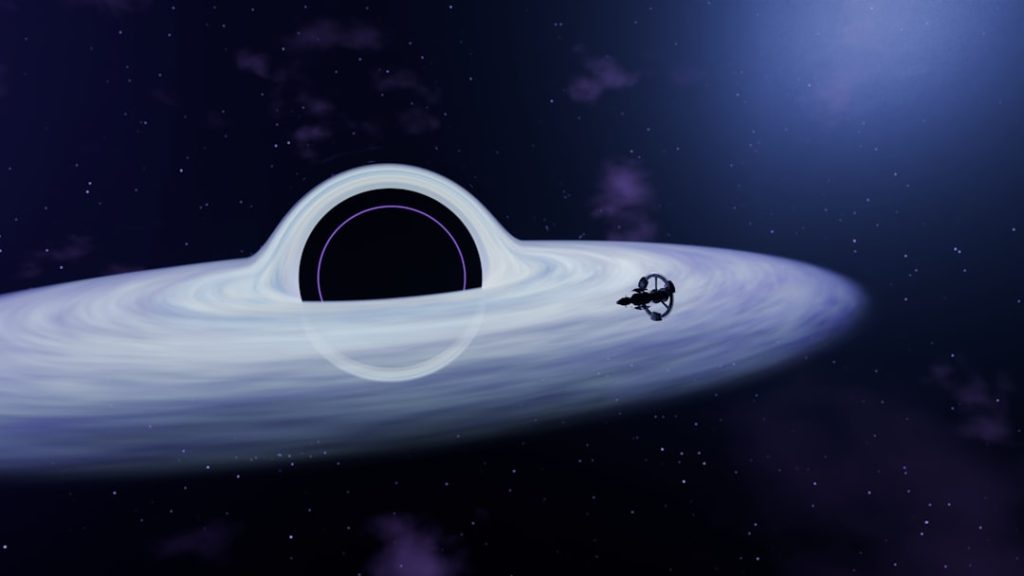A black hole is a region in space where the gravitational pull is so intense that nothing, not even light, can escape from it. This phenomenon arises from the warping of spacetime caused by a significant concentration of mass. The concept of a black hole challenges our understanding of physics, particularly the laws of gravity as described by Einstein’s General Theory of Relativity.
In essence, a black hole represents a point in the universe where the gravitational forces are so strong that they create a singularity—a point of infinite density and zero volume—at its core. The term “black hole” was first coined by physicist John Archibald Wheeler in 1967, but the idea has roots that trace back to the early 18th century with the work of Isaac Newton and later, Albert Einstein. Black holes can be classified into several categories based on their mass: stellar black holes, which form from the remnants of massive stars; supermassive black holes, which reside at the centers of galaxies and can contain millions to billions of times the mass of our Sun; and intermediate black holes, which are less understood and thought to exist between these two extremes.
Each type plays a unique role in the cosmic landscape, influencing the behavior of surrounding matter and the evolution of galaxies.
Key Takeaways
- A black hole is a region in space where the gravitational pull is so strong that nothing, not even light, can escape.
- Black holes are formed when massive stars collapse under their own gravity, or when two smaller black holes merge.
- Black holes have properties such as mass, spin, and charge, and are classified into different types based on these properties.
- The event horizon is the boundary around a black hole beyond which nothing can escape, and it is the point of no return.
- Black holes can influence their surroundings by emitting powerful jets of radiation and affecting the orbits of nearby stars and planets.
The Formation of Black Holes
The formation of black holes primarily occurs through the gravitational collapse of massive stars. When a star exhausts its nuclear fuel, it can no longer support itself against gravitational forces. For stars with a mass greater than approximately three solar masses, this collapse leads to the creation of a black hole.
As the core collapses, it compresses matter into an incredibly small volume, resulting in an event horizon—the boundary beyond which nothing can escape. Another pathway to black hole formation is through the merger of neutron stars or other black holes. When two neutron stars orbit each other closely, they can eventually spiral inward due to the emission of gravitational waves, ultimately merging to form a more massive black hole.
This process not only contributes to the population of black holes in the universe but also produces significant gravitational waves that can be detected by observatories like LIGO and Virgo. Additionally, supermassive black holes may form through the gradual accumulation of mass over time, as gas and dust fall into them or through the merging of smaller black holes.
The Properties of Black Holes

Black holes possess several intriguing properties that distinguish them from other celestial objects. One of the most notable characteristics is their mass, which determines their gravitational influence on surrounding matter. The mass of a black hole can be inferred from its effects on nearby stars and gas clouds.
For instance, astronomers have observed the orbits of stars around Sagittarius A*, the supermassive black hole at the center of our Milky Way galaxy, allowing them to estimate its mass at approximately 4 million solar masses. Another critical property is spin, which refers to the rotation of a black hole around its axis. A spinning black hole can drag spacetime around with it, a phenomenon known as frame-dragging.
This effect can influence the motion of objects nearby and is an essential consideration in understanding the dynamics of accretion disks—disks of gas and dust that spiral into black holes. Additionally, black holes can possess electric charge, although most astrophysical black holes are expected to be neutral due to processes that tend to neutralize any charge over time.
The Event Horizon
| Metrics | Data |
|---|---|
| Event Name | The Event Horizon |
| Date | October 15, 2022 |
| Location | New York City |
| Attendees | 500+ |
| Speakers | 10 |
| Topics | Technology, Innovation, Future Trends |
The event horizon is perhaps one of the most fascinating aspects of a black hole. It represents the boundary beyond which no information or matter can escape the gravitational pull of the black hole. Once an object crosses this threshold, it is inexorably drawn toward the singularity at the center.
The event horizon is not a physical surface but rather a mathematical boundary defined by the escape velocity exceeding the speed of light. The size of the event horizon is directly related to the mass of the black hole; larger black holes have correspondingly larger event horizons. For example, a stellar black hole with a mass three times that of our Sun would have an event horizon with a radius of about nine kilometers.
In contrast, supermassive black holes can have event horizons that extend for millions or even billions of kilometers. The study of event horizons has profound implications for our understanding of physics, particularly in relation to concepts such as time dilation and the nature of information in quantum mechanics.
The Influence of Black Holes on their Surroundings
Black holes exert a profound influence on their surroundings, shaping the dynamics and evolution of galaxies and star systems. Their immense gravitational pull can attract nearby stars and gas clouds, leading to complex interactions that can result in phenomena such as accretion disks and relativistic jets. Accretion disks are formed when matter spirals into a black hole, heating up due to friction and emitting intense radiation across various wavelengths, including X-rays and gamma rays.
Moreover, supermassive black holes at the centers of galaxies play a crucial role in regulating star formation within their host galaxies. The energy released during accretion processes can heat surrounding gas, preventing it from cooling and collapsing into new stars. This feedback mechanism can influence galaxy evolution over cosmic timescales, leading to a delicate balance between star formation and black hole growth.
Observations have shown that there is often a correlation between the mass of supermassive black holes and the properties of their host galaxies, suggesting that they co-evolve over time.
The Search for Black Holes

The search for black holes has been one of the most exciting endeavors in modern astrophysics. While they cannot be observed directly due to their nature, astronomers employ various indirect methods to detect their presence. One common technique involves observing the motion of stars around an invisible object; by analyzing their orbits, scientists can infer the mass and location of a black hole.
For instance, studies of stars orbiting Sagittarius A* have provided compelling evidence for its existence. Another method involves detecting X-ray emissions from accretion disks surrounding stellar black holes. When matter falls into a black hole, it heats up and emits X-rays before crossing the event horizon.
Instruments like NASA’s Chandra X-ray Observatory have been instrumental in identifying these high-energy emissions from binary systems containing black holes. Additionally, gravitational wave observatories like LIGO have opened up new avenues for detecting merging black holes through ripples in spacetime caused by their collisions.
The Future of Black Hole Exploration
The future of black hole exploration holds immense promise as technology advances and our understanding deepens. Upcoming missions such as the James Webb Space Telescope (JWST) are expected to provide unprecedented insights into the formation and evolution of black holes across cosmic history. By observing distant galaxies and their central supermassive black holes, astronomers hope to unravel the mysteries surrounding their growth and influence on galaxy formation.
Moreover, advancements in gravitational wave astronomy will continue to revolutionize our understanding of black holes. As more events are detected, researchers will gain insights into the population statistics of black holes, their merger rates, and even potential connections to dark matter. Theoretical developments in quantum gravity may also shed light on fundamental questions regarding what happens at the singularity and how information is preserved in black hole physics.
The Role of Black Holes in the Universe
Black holes play an integral role in shaping the universe as we know it. They are not merely cosmic vacuum cleaners; rather, they are fundamental components that influence galactic structure and evolution. Supermassive black holes at galactic centers are believed to regulate star formation and drive galactic dynamics through their immense gravitational influence and energetic feedback mechanisms.
Furthermore, black holes serve as natural laboratories for testing theories of physics under extreme conditions. They challenge our understanding of gravity, quantum mechanics, and thermodynamics—particularly through concepts like Hawking radiation proposed by Stephen Hawking, which suggests that black holes can emit radiation due to quantum effects near their event horizons. This interplay between general relativity and quantum mechanics remains one of the most profound challenges in theoretical physics.
In summary, black holes are not just enigmatic objects lurking in the cosmos; they are pivotal players in the grand tapestry of the universe. Their formation processes, properties, and interactions with surrounding matter provide critical insights into fundamental questions about existence itself. As we continue to explore these fascinating entities, we edge closer to unraveling some of the deepest mysteries that govern our universe.


